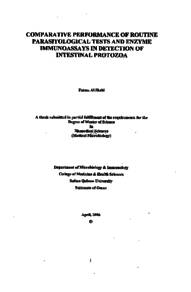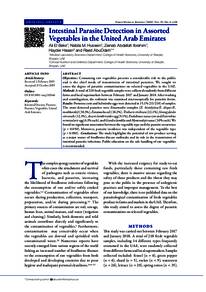وثيقة
Comparative performance of routine parasitological tests and enzyme immunossays in detection of intestinal protozoa
الناشر
Sultan Qaboos University
ميلادي
2006
اللغة
الأنجليزية
الملخص الإنجليزي
It is well known that Entamoeba histolytica, Giardia lamblia and Cryptosporidium spp can cause severe symptoms in humans. The diagnosis of these protozoan parasites depends on microscopic detection of their cysts or trophozoites in faeces. The aim of current study was to evaluate the use of three enzyme immunoassay (EIA) kits: Entamoeba CELISA (Cellabs diagnostic, Australia), Giardia CELISA (Cellabs diagnostic, Australia) and Crypto CELISA (Cellabs diagnostic, Australia) for detection of the above mentioned intestinal Protozoans. It also aimed to compare the performance of these immunoassay kits with microscopy called Ova and Parasite (O&P) examination tests namely, direct faecal wet smears preparations, formalin-ether concentration, Gomori's trichrome stain and auramine phenol staining routinely performed in the diagnostic Microbiology laboratory at Sultan Qaboos University Hospital. A total of 571 stool specimens were collected and examined by the three CELISA kits and the four microscopy tests. Giardia CELISA and Crypto CELISA were found to be more sensitive and specific than microscopy. The sensitivity of both kits was 100% and the specificity was 99% and 95% respectively. The performance of Entamoeba CELISA kit could not be established due to the small number of E. histolytica positive specimens. The enzyme immunoassay kits were easy to run and read compared to the cumbersome, labour intensive and more subjective O&P tests. The enzyme immunoassays may not replace O&P tests but may be used to confirm the clinical diagnosis of intestinal Protozoa.
المجموعة
URL المصدر
الملخص العربي
من المعروف أن الإصابة بطفيليات الإنتامبيا هيستوليتيكا, جباريا لإميليا وكريتوسبورينيوم تسبب العديد من الأمراض الخطيرة. ويتم الكشف عن هذه الطفيليات بواسطة الميكروسكوب وذلك بالعثور على إحدى مراحل دورة حياتها: الكيس أو الحييوين الإغتذائي. إن هذه الدراسة تهدف إلى تقييم استخدام ثلاثة أنواع من إنزيم المقايسة المناعية و هي: انتامیبا سیلیسا (سيلابس, أستراليا), جيارديا سيليسارسيلابس, أستراليا) و كريبتو سیلیسا سیلابس, أستراليا) المخصصة للكشف عن الطفيليات المذكورة آنفا. ومن أهداف الدراسة أيضا المقارنة بين أداء اختبارات إنزيم المقايسة المناعية وفحوصات الميكروسكوب التي يطلق عليها فحوصات البيض و الطفيليات وهي: فحص الميكروسكوب المباشر, طريقة التركيز بالفورمالين و الإيثر, صبغة التريكروم, صبغة الأورامين فينول و التي تجري روتينيا في مختبر الأحياء الدقيقة بمستشفى جامعة السلطان قابوس. وتم فحص عينات براز بلغ مجموعها571 عينة بواسطة الثلاثة أنواع من إختبار إنزيم المقايسة المناعية وفحوصات الميكروسكوب. و ظهر أن فحص جيارديا سيليسا و كريبتو سیلیسا افضل من الميكروسكوب من حيث الحساسية و الدقة وقد بلغت مدى حساسيتهما 100% ومدى الحقة و9% و 95% لكل منهما بالتوالي. أما بالنسبة لإختبار إنتاميبا سيليسا فقد كان من الصعب تقييم أدائه بسبب النسبة الضئيلة جدا من طفيل الإنتامیبا هیستوليتيكا والتي تم العثور عليها في هذه الدراسة. إن إستخدام اختبارات إنزيم المقايسة المناعية لا يمكن أن تحل محل الميكروسكوب ولكنها قد تساعد في تأكيد الإصابة بالطفيليات المعوية.
قالب العنصر
الرسائل والأطروحات الجامعية


